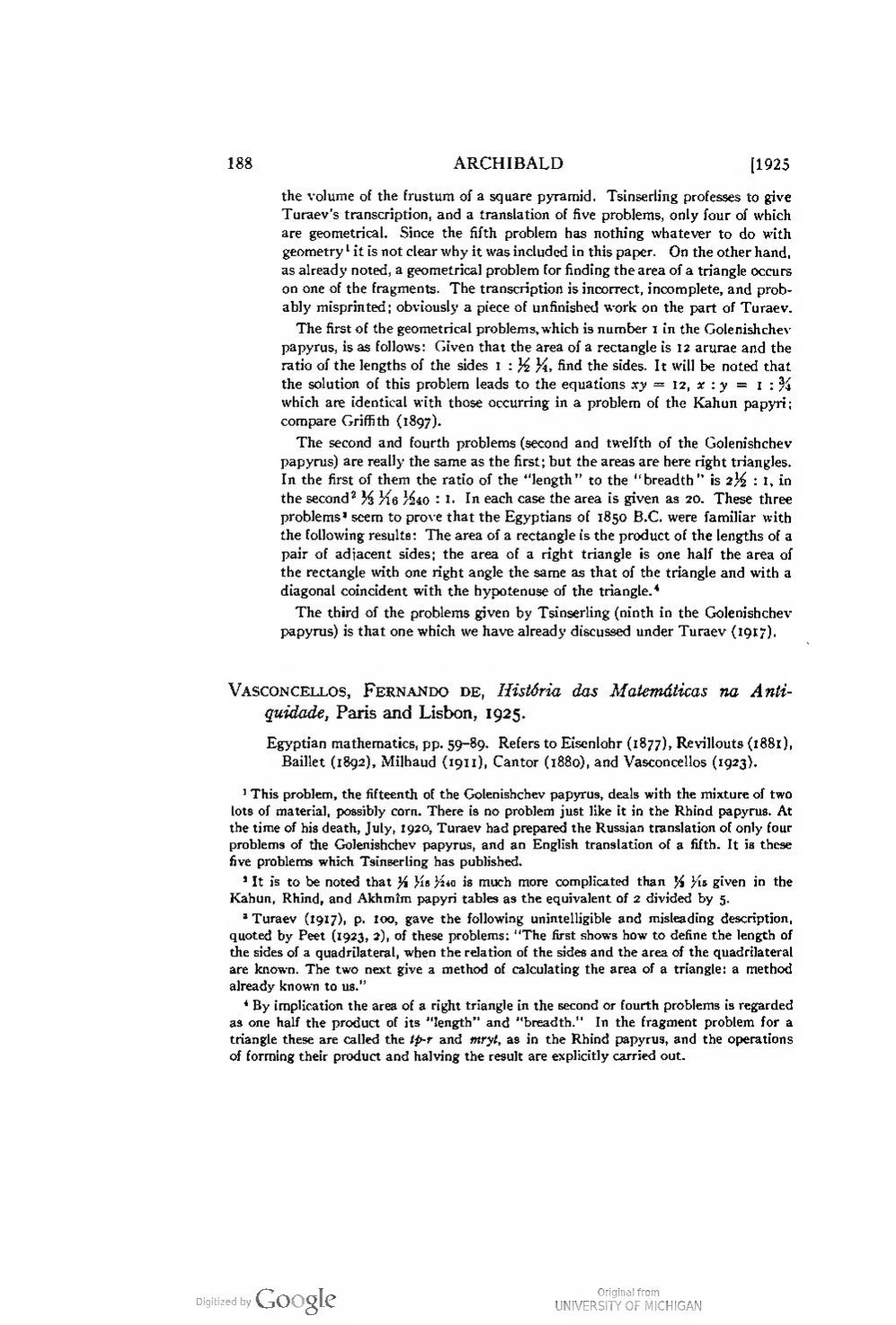the volume of the frustum of a square pyramid. Tsinserling professes to give Turaev's transcription, and a translation of five problems, only four of which are geometrical. Since the fifth problem has nothing whatever to do with geometry[1] it is not clear why it was included in this paper. On the other hand, as already noted, a geometrical problem for finding the area of a triangle occurs on one of the fragments. The transcription is incorrect, incomplete, and probably misprinted; obviously a piece of unfinished work on the part of Turaev.
The first of the geometrical problems, which is number 1 in the Golenishchev papyrus, is as follows: Given that the area of a rectangle is 12 arurae and the ratio of the lengths of the sides 1 : 1⁄2 1⁄4, find the sides. It will be noted that the solution of this problem leads to the equations xy = 12, x : y = 1 : 3⁄4 which are identical with those occurring in a problem of the Kahun papyri; compare Griffith (1897).
The second and fourth problems (second and twelfth of the Golenishchev papyrus) are really the same as the First; but the areas are here right triangles. In the First of them the ratio of the "length" to the "breadth" is 21⁄2 : 1 , in the second[2] 1⁄3 1⁄16 1⁄240 : 1. In each case the area is given as 20. These three problems[3] seem to prove that the Egyptians of 1850 B.C. were familiar with the following results: The area of a rectangle is the product of the lengths of a pair of adiacent sides; the area of a right triangle is one half the area of the rectangle with one right angle the same as that of the triangle and with a diagonal coincident with the hypotenuse of the triangle.[4]
The third of the problems given by Tsinserling (ninth in the Golenishchev papyrus) is that one which we have already discussed under Turaev (I917).
Vasconellos, Fernando de, Histéria das Matemdticas na Antiguidade, Paris and Lisbon, 1925.
Egyptian mathematics, pp. 59-89. Refers to Eisenlohr (1877), Revillouts (1881). Baillet (1892), Milhaud (1911), Cantor (1880), and Vasconcellos (1923).
- ↑ This problem, the fifteenth of the Golenishchev papyrus, deals with the mixture of two lots of material, possibly corn. There is no problem just like it in the Rhind papyrus. At the time of his death, July, 1920, Turaev had prepared the Russian translation of only four problems of the Golenishchev papyrus, and an English translation of a fifth. It is these five problems which Tsinserling has published.
- ↑ It is to be noted that 1⁄3 1⁄16 1⁄240 is much more complicated than 1⁄3 1⁄15 is given in the Kahun, Rhind, and Akhmim papyri tables as the equivalent of 2 divided by 5.
- ↑ Turaev (1917), p. 100, gave the following unintelligible and misleading description, quoted by Peet (1923, 2), of these problems: "The first shows how to define the length of the sides of a quadrilateral, when the relation of the sides and the area of the quadrilateral are known. The two next give a method of calculating the area of a triangle: a method already known to us."
- ↑ By implication the area of a right triangle in the second or fourth problems is regarded as one half the product of its "length" and "breadth." In the fragment problem for a triangle these are called the tp-r and mryt, as in the Rhind papyrus. and the operations of forming their product and halving the result are explicitly carried out.
